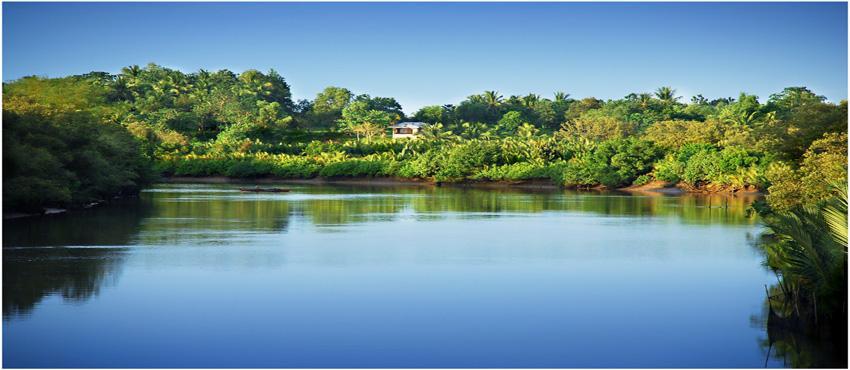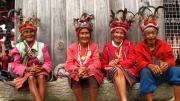
Local Trinidad Scenery
The Municipality of Trinidad is located in the northeastern part of Bohol Province, and this town is surprisingly rich in natural wonders, drawing thousands of visitors every year to its amazing caves and waterfalls, among others. Trinidad has a land area of 15,263.0344 hectares that comprises twenty (20) barangays. The topography is characterized by level plains on the eastern part, which gently undulates to hills and mountains toward the western part.
History
During the pre-Spanish period, a group of migrants established a settlement in a place along the river. The place was known as CABIZON after the buri fabric that was the prime commodity of the area. The settlement was heavily infested with mosquitoes; and nets made from the buri fabric were a necessary household fixture.
When the Spanish friars established themselves in the area, Cabizon was renamed “Ipil” in reference to the giant ipil-ipil trees abundant along the riverbanks. Ipil together with Ubay and the interior parts of Talibon had cattle ranches. Ipil was a convenient stopover for the cattle trade and was established as a sub-commercial center.
Ipil was flourishing until the early American colonial period circa 1900, when Ipil disintegrated and was subdivided between the Municipalities of Talibon and Ubay. At that time, the town’s Chief Executive, Lucas Hinlayagan, ceded all barangays west of the Ipil River to Talibon and those on the eastern part to Ubay.
The “Ipilanos” desired to regain its autonomy. Through the able guidance of Juan Gonzales, the Ipilanos’ desire was realized on August 14, 1947 when the Municipal Charter (Executive Order No. 80) was signed by the late President Manuel A. Roxas, establishing the once known “Ipil” and surrounding barangays to comprise the Municipality of Trinidad. It was then on September 01, 1947 that the Municipality of Trinidad was established. Trinidad was named on the basis of the following:
- After the name of the wife of the late President Manuel A. Roxas.
- In honor of the Patron of Talibon – The Most Holy Trinity.
- Being located at the junction of 3 major routes to Tagbilaran, the capital city of the province – the interior, northeastern and northwestern routes.
Tourism
The Batungay Cave
A yet unexplored wonder in the island of Bohol is the Batungay Cave, located in the interior part of the town of Trinidad.
Trinidad is 98 kilometers through the interior route, 128 kilometers through the northern route, 138 kilometers through the eastern route from the capital city of Tagbilaran and became a separate municipality from the larger Talibon town on September 1, 1947.
The Batungay Cave is in the forested area of barangay Sto. Tomas, 8 kms. from the town proper. It spans more than 700 meters within the Batungay Twin Peak. Batungay is derived from the word ""bato," meaning rock, and ""ngay," meaning twins. The cave is beneath two solid rocks.
During the 1970s, wild monkeys, tarsiers, rare bird species such as kalaw and lapay, and wild deer, pig, chicken, and ducks abound inside the cave and within its vicinity. Massive hunting of wildlife and kaingin have caused the decline of these animal species. The Trinidad local government has done its part in preserving the cave. Through Municipal Ordinance No. 97-01, hunting and poaching of its flora and fauna are prohibited and penalized, hence ensuring the protection and preservation of the cave.
Getting inside the Batungay Cave is exhilarating. A flowing stream of crystal clear water would definitely make your trek cooler and more enchanting. Add to that the awesome stalactites and stalagmites shaped like chandeliers, curtains, altars, and tables. Adventurous explorers will find out that the cave has enough room for the wildlife. The "langub sa has" or the cave of the snakes literally has snakes in there. The "langub sa kabyaw" is a habitat for bats. This crevice is in fact a rich depository of guano or bat manure, a natural fertilizer. In Batungay, you will also find the "langub sa simbahan," which has magnificent Caroline stalactites that glitter in the dark, like huge chandeliers that hang in cathedrals.
There is also the "langub sa binlanan," where the traditional healers or the tambalans prepare their medicinal herbs and do their oraciones or rituals. They leave portions of their concoctions in this cave, as well as food, as an offering to the apo of the cave. The tambalans go through the cave’s natural canals to reach yet another cave called Ilihan in the town of Alicia. Ilihan cave is regarded as the sister cave of Batungay.
Outside the Batungay Cave, you will find Batungay Peak, which is 150 feet above the ground. It is a perfect place for mountain climbing.
Like any other cave, Batungay has a myth to tell. According to the late Pantaleon Cajes, the first Barangay Captain in Sto. Tomas, there was a diwata in Batungay who was very generous to the residents.
This diwata would lend a wedding dress to a lady who is about to get married. She would also lend them pots, plates, and glasses for the banquet. But because the residents did not return these things back, the diwata ceased to let them borrow anything. Another popular myth about the Batungay is that it is a large plantation of cacao, and that these goods are transported to the Inabanga River on board the vessel of Magkaban, an enchanted merchant. These myths have been passed on through word of mouth by residents. The cave has a more functional value than just a source of magical stories. During World War II, Batungay became a refuge for locals from the onslaught of the Japanese soldiers. The cave was lucky enough to have been spared from the bombs during the war.
Now, local and foreign guests can simply add Batungay Cave to their list of wonderful sites to visit in the island of Bohol.
Kawasan Falls
Another location that has much potential as a tourist attraction is Kawasan Falls. It is located in barangay San Isidro, which is 13 kilometers away from the Poblacion proper and is 5 kilometers away from Batungay Cave.
Gallery


Accommodations
The Trinidad Municipal Training Center accommodates and caters to trainings, seminars and workshops for both public and private individuals. Rooms are available for walk-in guests. A number of pension houses are located at the neighboring municipalities of Ubay and Talibon, Bohol.










